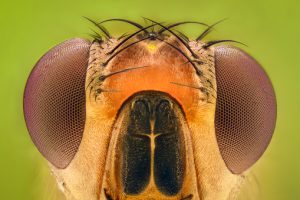
Scientists from Purdue University have been investigating the reasons behind human ocular diseases that can lead to vision loss, such as macular degeneration, and are doing so in a peculiar method using fruit flies.
Fruit fly sensitivity to blue light
It has been known for many years that blue light will make fruit flies go blind, but it wasn’t clear exactly why. However, assistant professor at Purdue’s Department of Biochemistry, Vikki Weake, and her colleagues have discovered why this is. This may shed some light on understanding the eye condition that affects humans, especially older adults.
They found that when comparing older fruit flies susceptible to the effects of blue light exposure to younger fruit flies’ immune to the light effects, retinal degeneration strongly correlated with lipid peroxidation; oxidative damage caused to lipids by reactive oxygen species. Young flies did not show this reaction.
“When you put older flies in the presence of really strong blue light, you basically overload the neurons and the photoreceptor cells in their eyes die. But this doesn’t have to be. There are natural conditions that confer resilience as we see with young flies. Cells in the eye are high in polyunsaturated fatty acids, and that makes those cells highly sensitive to this type of damage. That makes this a very dangerous environment,” said Weake.
Mitigating the negative effects of blue light on fruit flies
If was found that by feeding strong antioxidants to the flies, they could reduce the level of peroxidation. Overexpression of a protein called cytochrome b5, which transports electrons to enzymes within cells, was also induced, which stimulates the activity of enzymes that detoxify reactive oxygen species.
Cytochrome b5 overexpression rescues the blue light-induced retinal degeneration. It strongly suggests that the cause of cell death in this blue light model is the lipid peroxidation. Reducing levels of other reactive oxygen species such as hydrogen peroxide didn’t show such a strong effect,” Weake said.
According to the researchers, fruit fly models can help discover how genetic therapies or drugs could slow or stop vision loss. Lipid peroxidation is believed to play an important role in the development of human retinal disease such as age-related macular degeneration, however, the researchers do admit that the way blue light affects human eyes are a bit different.
Related: How to improve vision: 11 home remedies to improve eye health